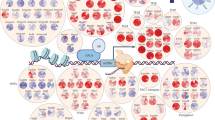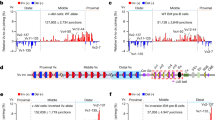Abstract
EGP-2, also known as Ep-CAM, is expressed at high levels on the surface of most carcinomas and is therefore considered an attractive target for anticancer strategies. To explore the mechanisms regulating the expression of EGP-2, sequences 3.4 kb upstream of the transcription start site were isolated and assayed for their ability to control the expression of the EGP-2 cDNA, the green fluorescent protein, the luciferase reporter gene and the thymidine kinase and cytosine deaminase suicide genes. Expression of these chimeric constructs as assessed in a range of different cell lines was restricted to cell lines expressing EGP-2. In addition, only cells expressing EGP-2 were sensitive for gancyclovir after being transiently transfected with EGP-2 promoter-driven thymidine kinase. Deletion analyses defined 687 bp upstream as the basic proximal promoter region, which could confer epithelial-specific expression to the GFP reporter gene in vitro. As these EGP-2 sequences can confer promoter activity to reporter and suicide genes in an EGP-2 restricted manner, they may be useful for gene therapy of EGP-2 expressing carcinomas.
This is a preview of subscription content, access via your institution
Access options
Subscribe to this journal
Receive 12 print issues and online access
$259.00 per year
only $21.58 per issue
Buy this article
- Purchase on Springer Link
- Instant access to full article PDF
Prices may be subject to local taxes which are calculated during checkout





Similar content being viewed by others
References
Haviv YS, Curiel DT, . Conditional gene targeting for cancer gene therapy. Adv Drug Deliv Rev. 2001;53:135–154.
Denny WA . Prodrug strategies in cancer therapy. Eur J Med Chem. 2001;36:577–595.
Balzar M, Winter MJ, de Boer CJ, Litvinov SV . The biology of the 17-1A antigen (Ep-CAM). J Mol Med. 1999;77:699–712.
Litvinov SV, Velders MP, Bakker HA, et al. Ep-CAM: a human epithelial antigen is a homophilic cell–cell adhesion molecule. J Cell Biol. 1994;125:437–446.
Meyaard L, van der Vuurst de Vries AR, de Ruiter T, et al. The epithelial cellular adhesion molecule (Ep-CAM) is a ligand for the leukocyte-associated immunoglobulin-like receptor (LAIR). J Exp Med. 2001;194:107–112.
Linnenbach AJ, Wojcierowski J, Wu SA, et al. Sequence investigation of the major gastrointestinal tumor-associated antigen gene family, GA733. Proc Natl Acad Sci USA. 1989;86:27–31.
Herlyn M, Steplewski Z, Herlyn D, Koprowski H . Colorectal carcinoma-specific antigen: detection by means of monoclonal antibodies. Proc Natl Acad Sci USA. 1979;76:1438–1452.
Riethmuller G, Holz E, Schlimok G, et al. Monoclonal antibody therapy for resected Dukes' C colorectal cancer: seven-year outcome of a multicenter randomized trial. J Clin Oncol. 1998;16:1788–1794.
Heideman DA, Snijders PJ, Craanen ME, et al. Selective gene delivery toward gastric and esophageal adenocarcinoma cells via EpCAM-targeted adenoviral vectors. Cancer Gene Ther. 2001;8:342–351.
de Leij LF, Postmus PE, Buys CH, et al. Characterization of three new variant type cell lines derived from small cell carcinoma of the lung. Cancer Res. 1985;12:6024–6033.
Mulder AB, Blom NR, Smit JW, et al. Basal tissue factor expression in endothelial cell cultures is caused by contaminating smooth muscle cells. Reduction by using chymotrypsin instead of collagenase. Thromb Res. 1995;80:399–411.
Farr A, Roman A . A pitfall of using a second plasmid to determine transfection efficiency. Nucleic Acids Res. 1992;20:920.
Werner T . Computer-assisted analysis of transcription control regions. Matinspector and other programs. Methods Mol Biol. 2000;132:337–349.
Evan GI, Lewis GK, Ramsey G, Bishop JM . Isolation of monoclonal antibodies specific for human c-myc proto-oncogene product. Mol Cell Biol. 1985;5:3610–3616.
Mosmann T . Rapid colorimetric assay for cellular growth and survival: application to proliferation and cytotoxicity assays. J Immunol Methods. 1983;16:55–63.
Szala S, Froehlich M, Scollon M, et al. Molecular cloning of cDNA for the carcinoma-associated antigen GA733-2. Proc Natl Acad Sci USA. 1990;87:3542–3546.
Struhl K . Fundamentally different logic of gene regulation in eukaryotes and prokaryotes. Cell. 1999;98:1–4.
Gires O, Kieu C, Fix P, et al. Tumor necrosis factor α negatively regulates the expression of the carcinoma-associated antigen epithelial cell adhesion molecule. Cancer. 2001;92:620–628.
Gires O, Eskofier S, Lang S, et al. Cloning and characterisation of a 1.1 kb fragment of the carcinoma-associated epithelial cell adhesion molecule promoter. Anticancer Res. 2003;23:3255–3262.
Smale ST, Schmidt MC, Berk AJ, Baltimore D . Transcriptional activation by Sp1 as directed through TATA or initiator: specific requirement for mammalian transcription factor IID. Proc Natl Acad Sci USA. 1990;87:4509–4513.
Lee JH, Jang SI, Yang JM, et al. The proximal promoter of the human transglutaminase 3 gene. Stratified squamous epithelial-specific expression in cultured cells is mediated by binding of Sp1 and ets transcription factors to a proximal promoter element. J Biol Chem. 1996;271:4561–4568.
Behrens J, Lowrick O, Klein-Hitpass L, Birchmeier W . The E-cadherin promoter: functional analysis of a G–C-rich region and an epithelial cell-specific palindrome regulatory element. Proc Natl Acad Sci USA. 1991;88:11495–11499.
Kovarik A, Peat N, Wilson D, et al. Analysis of the tissue-specific promoter of the MUC1 gene. J Biol Chem. 1993;268:9917–9926.
Lin CS, Chen Y, Huynh T, Kramer R . Identification of the human alpha6 integrin gene promoter. DNA Cell Biol. 1997;16:929–937.
Hennig G, Lowrick O, Birchmeier W, Behrens J . Mechanisms identified in the transcriptional control of epithelial gene expression. J Biol Chem. 1996;271:595–602.
Oettgen P, Alani RM, Barcinski MA, et al. Isolation and characterization of a novel epithelium-specific transcription factor, ESE-1, a member of the ets family. Mol Cell Biol. 1997;17:4419–4433.
McLaughlin PM, Harmsen MC, Dokter WH, et al. The epithelial glycoprotein 2 (EGP-2) promoter-driven epithelial-specific expression of EGP-2 in transgenic mice: a new model to study carcinoma-directed immunotherapy. Cancer Res. 2001;61:4105–4111.
Kuriyama S, Nakatani T, Masui K, et al. Bystander effect caused by suicide gene expression indicates the feasibility of gene therapy for hepatocellular carcinoma. Hepatology. 1995;22:1838–1846.
Author information
Authors and Affiliations
Corresponding author
Rights and permissions
About this article
Cite this article
McLaughlin, P., Trzpis, M., Kroesen, BJ. et al. Use of the EGP-2/Ep-CAM promoter for targeted expression of heterologous genes in carcinoma derived cell lines. Cancer Gene Ther 11, 603–612 (2004). https://doi.org/10.1038/sj.cgt.7700725
Received:
Published:
Issue Date:
DOI: https://doi.org/10.1038/sj.cgt.7700725
Keywords
This article is cited by
-
Transcription factors and molecular epigenetic marks underlying EpCAM overexpression in ovarian cancer
British Journal of Cancer (2011)
-
EpCAM homologues exhibit epithelial-specific but different expression patterns in the kidney
Transgenic Research (2008)
-
DNA methylation and histone modification regulate silencing of epithelial cell adhesion molecule for tumor invasion and progression
Oncogene (2007)
-
The carcinoma-specific epithelial glycoprotein-2 promoter controls efficient and selective gene expression in an adenoviral context
Cancer Gene Therapy (2006)



